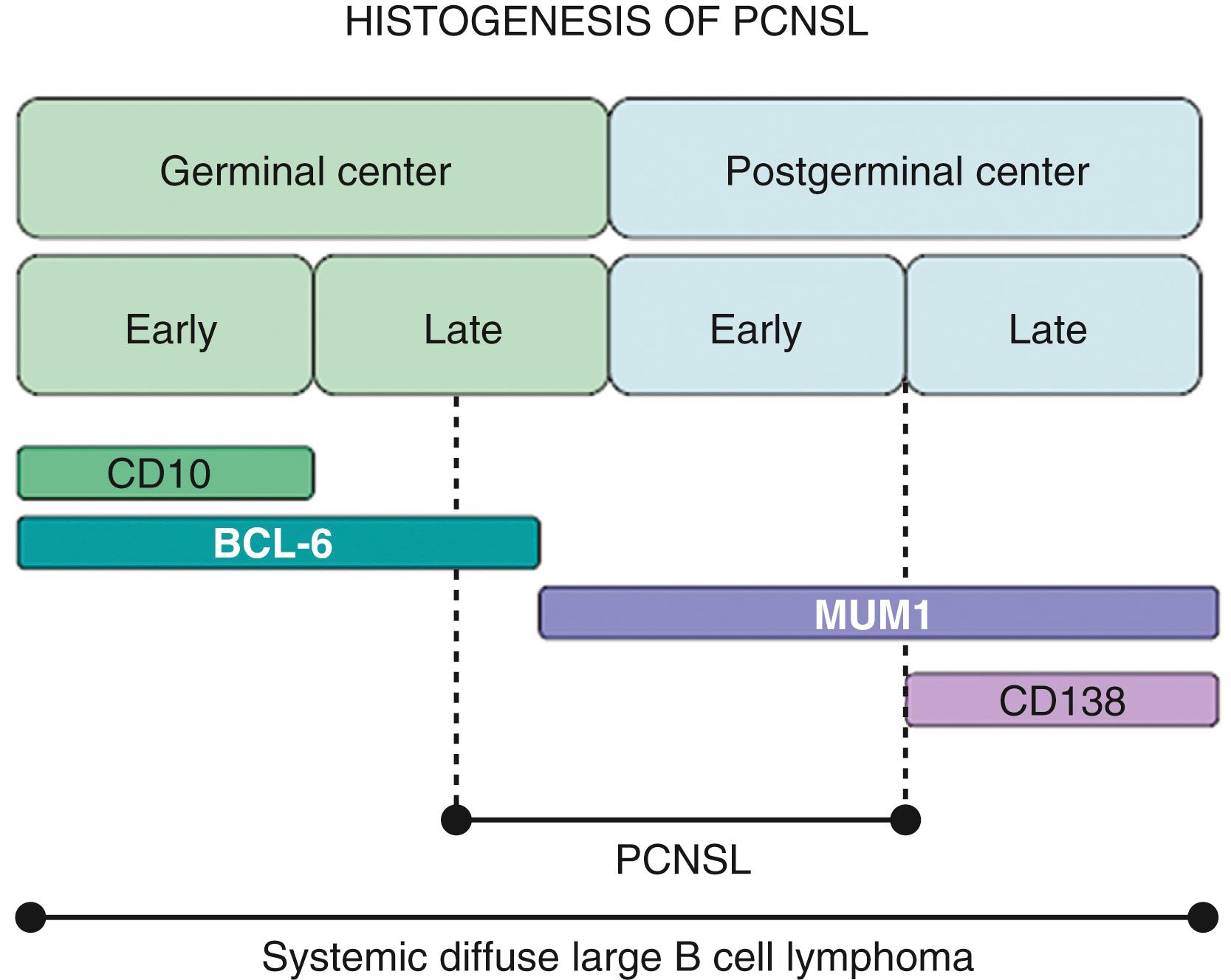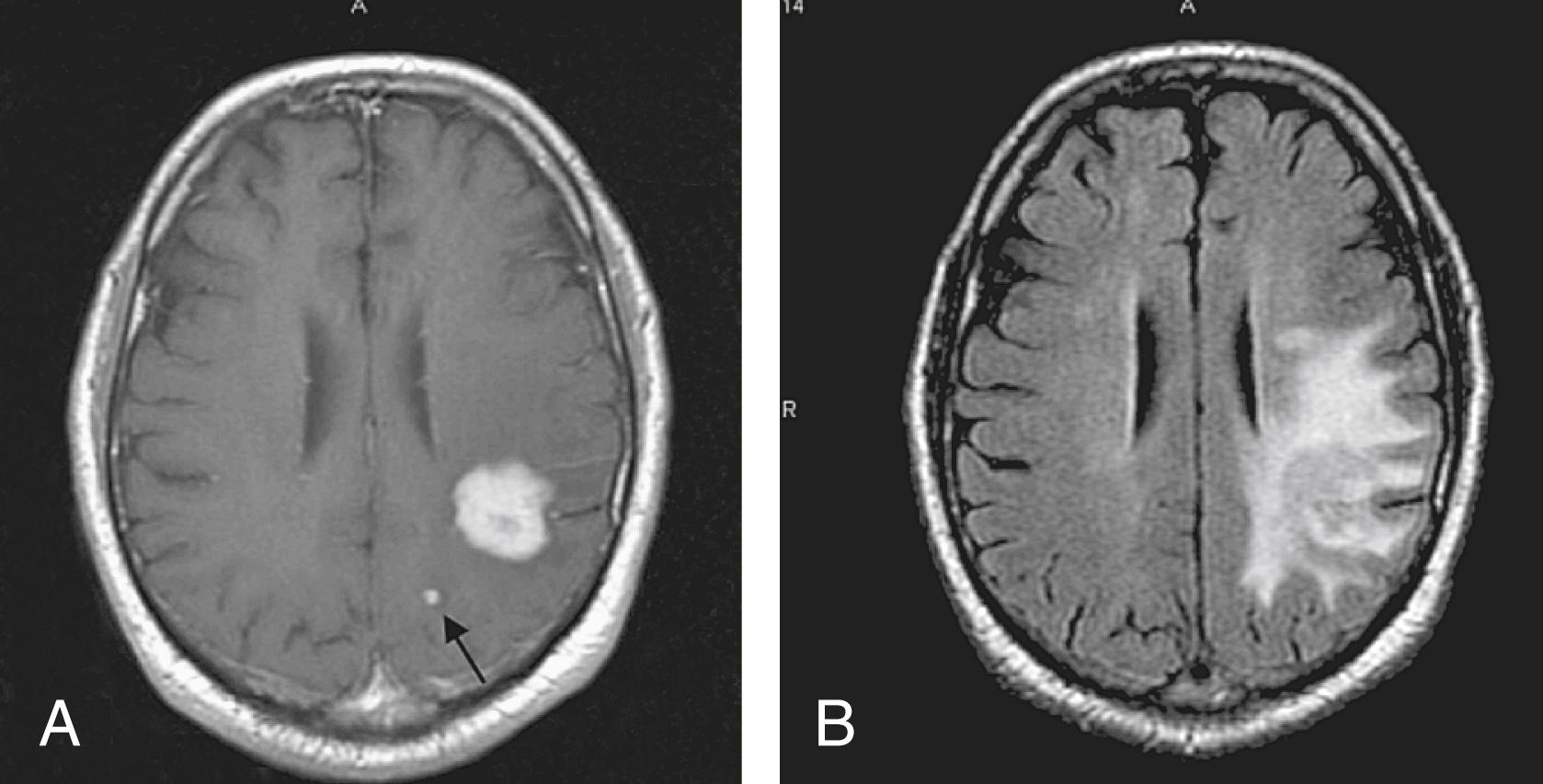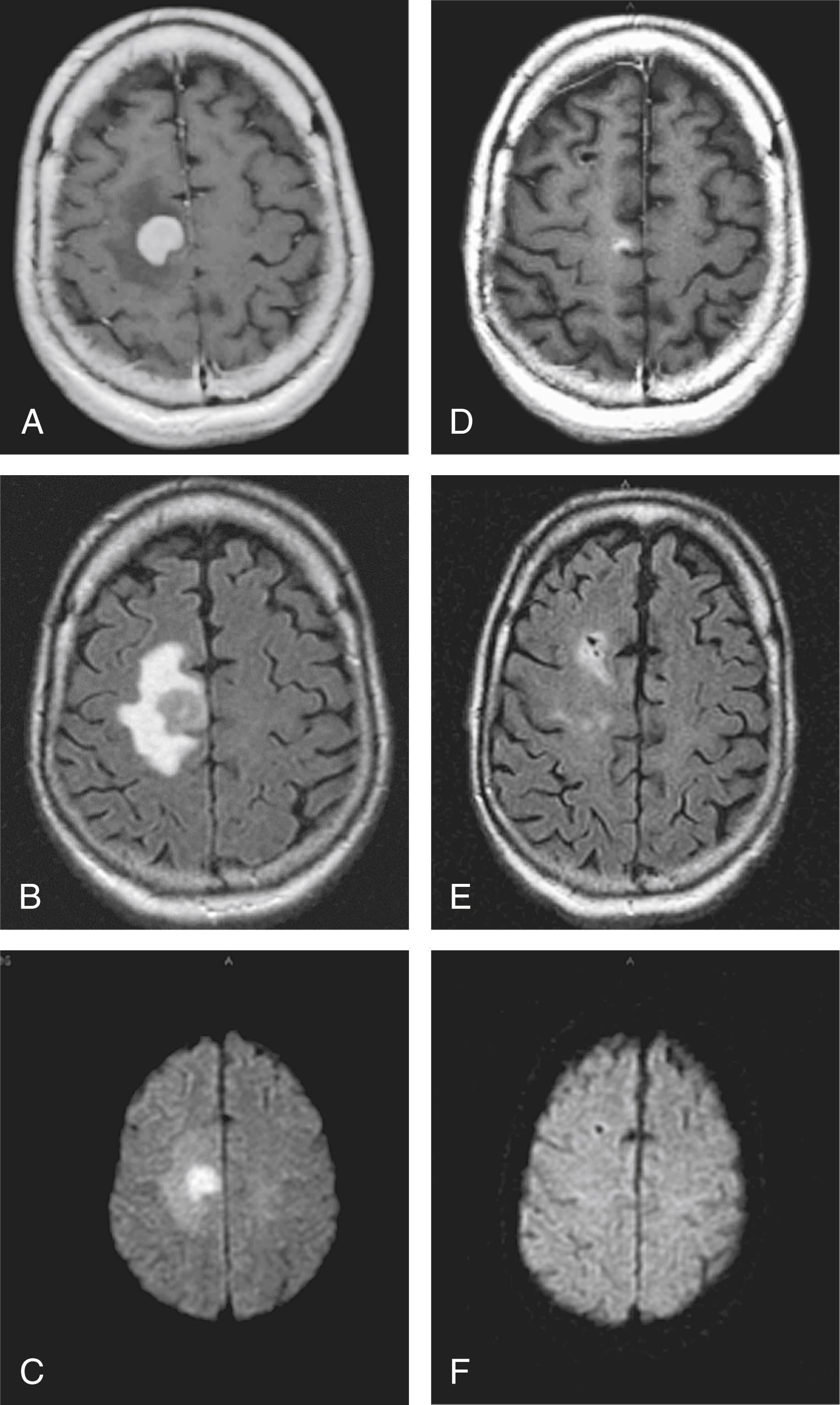Physical Address
304 North Cardinal St.
Dorchester Center, MA 02124
Primary central nervous system lymphoma (PCNSL) is a category of extranodal lymphoma restricted to the nervous system accounting for approximately 3% of all brain tumors. Histologically, the majority of these tumors are identified as large B-cell lymphomas; however, T-cell lymphoma cases have also been reported ( Fig. 9.1 ). PCNSL most commonly presents as a single intracranial mass; however, in 20% to 40% of immunocompetent patients, multiple masses may be observed ( Fig. 9.2 ). Classically, periventricular white matter involvement is seen, though any craniospinal structure can be involved. Uncommonly, these lymphomas can arise in the spinal cord, meninges, and eyes. These brain lesions are frequently accompanied by leptomeningeal and ocular dissemination.


PCNSLs are histologically hypercellular with minimal vascularization, resulting in several characteristic imaging findings. On computed tomography (CT) imaging with contrast, these highly cellular lesions appear as high density. , On magnetic resonance imaging (MRI), PCNSLs have intense and homogenous nodular enhancement with a well-defined margin in immunocompetent patients (see Fig. 9.2A ). Perilesional vasogenic edema is often observed (see Fig. 9.2B ). Similar to other intracranial tumors, PCNSLs appear hypointense to gray matter on T1 weighted imaging. They may be differentiated on T2 weighted imaging, as their hypercellularity implies short T2 relaxation times, resulting in an isointense to hypointense appearance. In the setting of high cellularity, restricted diffusion of water is noted on diffusion-weight imaging. This results in hyperintensity on DWI trace images and hypointensity on apparent diffusion coefficient maps ( Fig. 9.3 ).

If central nervous system (CNS) lymphoma is suspected based on imaging findings, assessment for extracranial disease should be performed to differentiate primary from secondary CNS lymphoma. Evaluation should include routine physical exam, blood studies, contrast-enhanced total-body CT scan or positron emission tomography (PET)/CT with contrast, and testicular ultrasound. In up to 8% of cases thought to be PCNSL, systemic disease has been found.
PCNSL, in contrast to secondary CNS lymphoma involvement, is overwhelmingly parenchymal in location. Rarely, PCNSL may present as primary dural lymphoma mimicking meningioma or as primary leptomeningeal lymphoma mimicking other causes of leptomeningitis. In immunocompetent patients, PCNSL is more commonly a solitary and homogenously enhancing mass but may be multifocal in up to 40% of cases and show ringlike enhancement in ∼10%. Edema is frequently present but often disproportionately low compared to other aggressive neoplasms, such as solid organ metastases and high-grade glioma. Likewise, there is also often disproportionately less mass effect than would be expected for the size. Features such as hemorrhage and calcification are rare in untreated, immunocompetent patients. Although classically described as having an affinity for the basal ganglia, only ∼⅓ are present in the basal ganglia. More commonly, the supratentorial white matter is involved, with frequent extension to the ependymal and/or meningeal surface. The frontal lobe white matter and corpus callosum are affected more often. Typical imaging features reflect the high cellularity and the increased nuclear-cytoplasmic ratio, including hyperdensity on noncontrast CT, iso- to hypointense on T2-weighted imaging, features that are less commonly seen in metastatic disease and gliomas. Additionally, the low interstitial water content and high nuclear-cytoplasmic ratio results in restricted water movement on diffusion-weighted imaging. Perfusion imaging shows a relatively mild increase in cerebral blood volume (CBV) compared to most metastatic lesions and high-grade gliomas. In the immunocompromised patient, atypical features are more common, including higher incidence of multifocality, frequent necrosis and heterogenous enhancement, and occasional hemorrhage (particularly in AIDS-related cases, compared to other causes of immune suppression).
Stereotactic biopsy is indicated for pathologic confirmation of PCNSL ( ). Of note, B-cell lymphomas are steroid sensitive; thus previous exposure to steroids may result in loss of diagnostic histologic findings. If PCNSL is suspected, steroids should be avoided when possible with expedient biopsy pursued. Upon diagnosis of PCNSL, baseline staging evaluation includes cerebrospinal fluid (CSF) sampling, ophthalmologic evaluation, and bone marrow biopsy. Additional pretreatment evaluation should include hepatic, renal, and cardiac functionality tests, HIV status, and hepatitis B and C panel.
Video 9.1
PCNSL, when left untreated in immunocompetent patients, results in median overall survival (OS) of less than 4 to 5 months. However, the median OS after the introduction of combination modality high-dose (HD) methotrexate (MTX)–based regimens shows survival of 2 to 5 years. Prognosis can be determined through various clinical models. The International Extranodal Lymphoma Study Group (IELSG) scoring model includes age greater than 60 years, elevated serum LDH, Eastern Cooperative Oncology Group score (ECOG) greater than 2, involvement of deep brain structures, and raised CSF protein levels. Two-year OS was 80%, 48%, 15% for patients with scores of 0 to 1, 2 to 3, and 4 to 5, respectively. Memorial Sloan-Kettering Cancer Center proposed a simplified score model including only age greater than 50 years and Karnofsky Performance Score (KPS) greater than 70. Patients less than 50 years old had a median survival of 8.5 years (95% CI, 4.7 to 16.8). Patients older than 50 with KPS greater than 70 had a median survival of 3.2 years (95% CI, 2.6 to 4.3). Patients older than 50 with KPS less than 70 had a median survival of only 1.1 years (95% CI, 1.4 to 4.3).
Become a Clinical Tree membership for Full access and enjoy Unlimited articles
If you are a member. Log in here